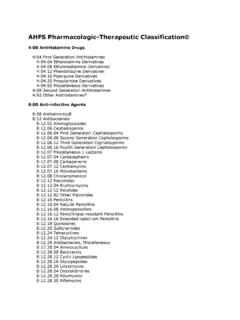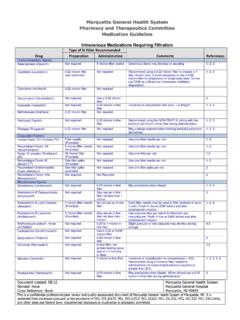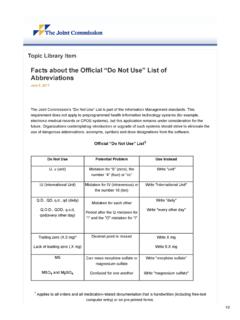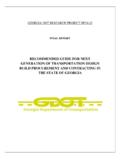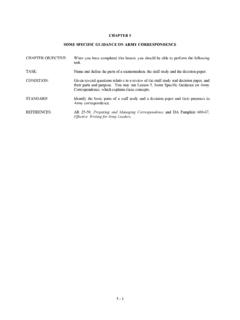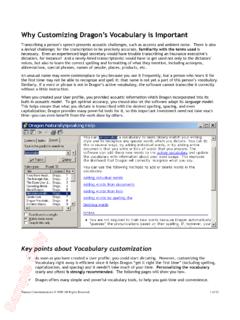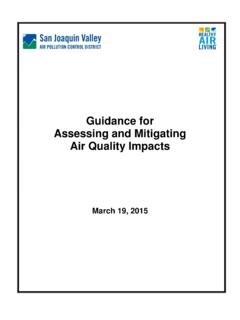Transcription of Facts about the Do Not Use list - Marquette …
1 Facts about the Official do not use List In 2001, The Joint Commission issued a Sentinel Event Alert on the subject of medical abbreviations , and just one year later, its Board of Commissioners approved a National Patient Safety Goal requiring accredited organizations to develop and implement a list of abbreviations not to use. In 2004, The Joint Commission created its do not use list of abbreviations (see next page) as part of the requirements for meeting that goal. In 2010, was integrated into the Information Management standards as elements of performance 2 and 3 under Currently, this requirement does not apply to preprogrammed health information technology systems (for example, electronic medical records or CPOE systems), but this application remains under consideration for the future.
2 Organizations contemplating introduction or upgrade of such systems should strive to eliminate the use of dangerous abbreviations , acronyms, symbols, and dose designations from the software. The National Summit on Medical abbreviations Participants at the November 2004 National Summit on Medical abbreviations supported the do not use . list. Summit conclusions were posted on the Joint Commission Web site for public comment. During the four-week comment period, the Joint Commission received 5,227 responses, including 15,485 comments. More than 80 percent of the respondents supported the creation and adoption of a do not use list.
3 However, the field was less supportive of additions to the list. While no additions will be made to the do not use list at this time, the following items will be reviewed periodically for possible inclusion: The symbols > and < . All abbreviations for drug names Apothecary units The symbol @ . The abbreviation cc . The abbreviation g . This special one-day Summit brought together representatives of more than 70 professional societies and associations and special interest groups to discuss medical errors related to the misuse and misinterpretation of abbreviations , acronyms, and symbols.
4 The objective of the Summit was to reach consensus on the scope and implications of this serious and complex problem and to find reasonable solutions using all of the evidence at hand and in the most dispassionate way possible. The National Summit on Medical abbreviations was hosted by The Joint Commission with its co-conveners American College of Physicians, American College of Surgeons, American Dental Association, American Hospital Association, American Medical Association, American Society of Health-System Pharmacists, Institute for Safe Medication Practices, and United States Pharmacopeia.
5 Approximately 50 professional societies and associations and selected interest groups participated in the Summit representing every perspective. For more information Contact the Standards Interpretation Group at (630) 792-5900, or complete the Standards Online Question Submission Form at 1. Official do not use List do not use Potential Problem Use Instead U, u (unit) Mistaken for 0 (zero), the Write "unit". number 4 (four) or cc . IU (International Unit) Mistaken for IV (intravenous) Write "International Unit". or the number 10 (ten). , QD, , qd (daily) Mistaken for each other Write "daily".
6 , QOD, , qod Period after the Q mistaken for Write "every other day". (every other day) "I" and the "O" mistaken for "I". Trailing zero ( mg)* Decimal point is missed Write X mg Lack of leading zero (.X mg) Write mg MS Can mean morphine sulfate or Write "morphine sulfate". magnesium sulfate Write "magnesium sulfate". MSO4 and MgSO4 Confused for one another 1. Applies to all orders and all medication-related documentation that is handwritten (including free-text computer entry) or on pre-printed forms. *Exception: A trailing zero may be used only where required to demonstrate the level of precision of the value being reported, such as for laboratory results, imaging studies that report size of lesions, or catheter/tube sizes.
7 It may not be used in medication orders or other medication-related documentation. Additional abbreviations , Acronyms and Symbols (For possible future inclusion in the Official do not use List). do not use Potential Problem Use Instead > (greater than) Misinterpreted as the number Write greater than . < (less than) 7 (seven) or the letter L Write less than . Confused for one another abbreviations for drug names Misinterpreted due to similar Write drug names in full abbreviations for multiple drugs Apothecary units Unfamiliar to many Use metric units practitioners Confused with metric units @ Mistaken for the number Write at.
8 2 (two). cc Mistaken for U (units) when Write mL . poorly written or "ml" or milliliters . ( mL is preferred). g Mistaken for mg (milligrams) Write "mcg" or micrograms . resulting in one thousand-fold overdose 2/12.
